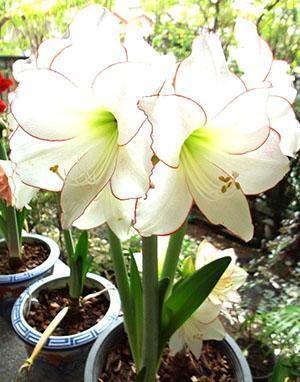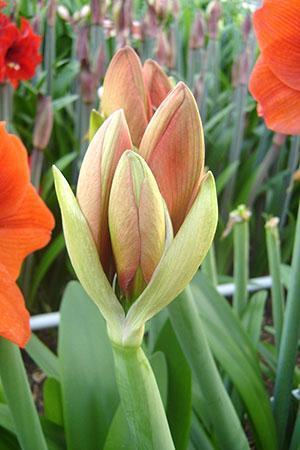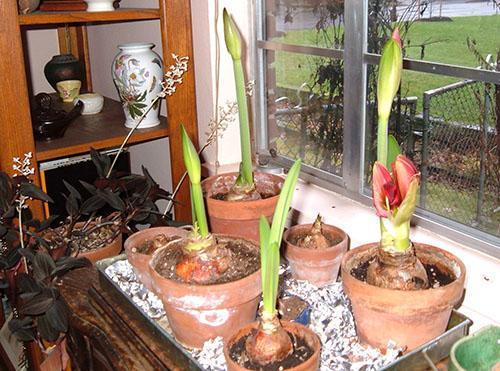Home care for hippeastrum
 In the wild, hippeastrum are found in South America, with a number of varieties found in subtropical climates and the tropics, while others prefer rocky slopes where conditions for growth are very harsh. The first bulbs came to Europe in the second half of the 16th century, and the flowering of the hippeastrum made a huge impression in the countries of the Old World, where the fashion for bulb crops was gaining strength.
In the wild, hippeastrum are found in South America, with a number of varieties found in subtropical climates and the tropics, while others prefer rocky slopes where conditions for growth are very harsh. The first bulbs came to Europe in the second half of the 16th century, and the flowering of the hippeastrum made a huge impression in the countries of the Old World, where the fashion for bulb crops was gaining strength.
Gradually the plant was studied, Europeans learned how to grow hippeastrum and how to care for a flower. Within a hundred years, the first hybrid plants were bred. And if in nature there are several dozen species of these bulbous plants, then the number of varieties already exceeds two thousand. Today, any florist who has ever seen the spectacular flowering of hippeastrum will certainly not leave the thought of decorating his own windowsill with a luxurious plant.
Hippeastrum: plant features
Depending on the type and age, the hippeastrum bulb has a diameter of 5 to 10 cm and consists of a short section of the stem and surrounding closed scales.
In the sinus of every fourth scale, rudiments are formed:
- peduncle, as it grows, reaching a height of 40–80 cm;
- future large, collected in inflorescences of 2-6 pieces of flowers.

The leaves of the hippeastrum are located opposite each other, in width, depending on the variety, do not exceed 4–5 cm, and reach 50–70 cm in length. A florist who is going to start growing hippeastrum should know that the year of this plant is divided into three distinct period:
- flowering;
- vegetation;
- rest.
When the long-awaited time of flowering comes, red, white pink, striped and spotted flowers sitting on the petioles open on the tops of the hollow peduncles.
Large bulbs can form two or three peduncles, but specimens with less than four leaves or not reaching a diameter of 6-7 cm this season are unlikely to please with flowering.
 Leaves appear one at a time approximately once a month, when, after flowering, the plant retires for a period of 2 to 3 months, there are no external signs of bulb development, but it is actively accumulating strength. Arrows with bright colors appear once a year, but with proper care, as in the photo, hippeastrum at home twice pleases with flowering. The timing and duration of this period depends on the selected variety, the characteristics of care, in particular, on the temperature in the room. On average, flowering lasts about three weeks.
Leaves appear one at a time approximately once a month, when, after flowering, the plant retires for a period of 2 to 3 months, there are no external signs of bulb development, but it is actively accumulating strength. Arrows with bright colors appear once a year, but with proper care, as in the photo, hippeastrum at home twice pleases with flowering. The timing and duration of this period depends on the selected variety, the characteristics of care, in particular, on the temperature in the room. On average, flowering lasts about three weeks.
 However, sometimes flower growers still cannot get flower arrows from the plant. How to care for hippeastrum so that in addition to leaves, the bulb regularly forms flower stalks? The reason for the lack of flowers is often incorrectly selected growing conditions for hippeastrum or the properties of the bulb:
However, sometimes flower growers still cannot get flower arrows from the plant. How to care for hippeastrum so that in addition to leaves, the bulb regularly forms flower stalks? The reason for the lack of flowers is often incorrectly selected growing conditions for hippeastrum or the properties of the bulb:
- A bulb that stays in a shaded place for a long time or on northern windows, where there is not enough light all year round, can refuse to bloom.
- With an overly spacious or cramped pot, hippeastrum also sometimes does not bloom.
- An incorrectly selected mode negatively affects the quality of flowering glaze, dressing and even the composition of the soil.
- Do not forget about the necessary 2.5-3 months rest for the bulb, when the hippeastrum is sent to a cool, dark place.
 If there are no apparent reasons for refusing to bloom, the bulb is healthy and well-fed, it can be forced to throw out the peduncle by resorting to one of their proven methods:
If there are no apparent reasons for refusing to bloom, the bulb is healthy and well-fed, it can be forced to throw out the peduncle by resorting to one of their proven methods:
- In the middle of summer, all leaves are cut from the bulbs and watering is stopped. After a month, watering is resumed and a single complex feeding is carried out. By the beginning of autumn, buds and flowers appear on the hippeastrum.
- A set of buds is also observed 20–25 days after the three-hour treatment of the bulb with water heated to 43–45 ° C.
- For the spring flowering of hippeastrum in August, the plant ceases to be watered and until January is transferred to a dark, cool place in a dark place. 5-6 weeks after resuming watering, the bulb will bud.
 For high-quality flowering, it is important that during the growing season and rest the bulb can recover and form a peduncle. If the bulb lacks nutrition, perhaps the moment has come when it is simply necessary to transplant the hippeastrum. This may be evidenced by the braiding by the roots of the entire earthy coma. Do not forget about feeding the hippeastrum.
For high-quality flowering, it is important that during the growing season and rest the bulb can recover and form a peduncle. If the bulb lacks nutrition, perhaps the moment has come when it is simply necessary to transplant the hippeastrum. This may be evidenced by the braiding by the roots of the entire earthy coma. Do not forget about feeding the hippeastrum.
Longer recovery during the growing season and during the dormant period requires small bulbs, as well as those that have suffered some kind of disease or pest attacks.
The dormant period involves removing healthy, well-prepared bulbs in a cool, dark place. Most often, the bulbs of hippeastrum "fall asleep" from September to January. How to care for a flower so that hippeastrum blooms in due time? Special care is not required at this time, and special conditions are created for the bulbs:
- The optimum temperature is 12-14 ° C.
- Complete blackout.
- The air is dry, the humidity does not exceed 50-60%.
- Watering and feeding is completely stopped.
How and when to transplant hippeastrum?
Hippeastrum quickly assimilate an earthen lump in a pot and literally suck out all the nutrients from the soil.
 Therefore, the plant can be transplanted almost every year. When is it more convenient and painless for a plant to transplant hippeastrum? The best time to transplant a bulb is:
Therefore, the plant can be transplanted almost every year. When is it more convenient and painless for a plant to transplant hippeastrum? The best time to transplant a bulb is:
- before being sent for storage during the rest period;
- after the release of their "hibernation";
- before flowering;
- after the end of flowering, in the case of a recently acquired plant in a transport pot and substrate.
Before replanting hippeastrum:
- dead scales are carefully removed from the bulbs;
- study the root system, if necessary, trimming rotten or damaged roots and treating the cut with a fungicide.
The soil for hippeastrum should be light, loose, low in acidity and high in nutrients and mineral salts.
 If you have to buy a ready-made mixture, for growing hippeastrum, it is better to choose soil for bulbous crops, and then, to make it friable, shift it with vermiculite or sand.
If you have to buy a ready-made mixture, for growing hippeastrum, it is better to choose soil for bulbous crops, and then, to make it friable, shift it with vermiculite or sand.
 When the earthen mixture is compiled on its own, use three parts of leaf earth and one part additive. humus, if necessary, sand and dolomite flour are mixed into the soil:
When the earthen mixture is compiled on its own, use three parts of leaf earth and one part additive. humus, if necessary, sand and dolomite flour are mixed into the soil:
- To grow hippeastrum, a pot is enough, the walls of which are 3 cm away from the bulb. More capacious dishes only harm flowering.
- A drainage layer is required at the bottom.
- And the bulb is planted so that most of it remains above the ground.
In the summer months, the bulbs can be planted in open ground, where the same care for the hippeastrum continues, in the photo, as at home. And before freezing, the bulbs are dug up and transferred to the room.
Lighting for growing hippeastrum
Hippeastrum are photophilous and feel best in the most illuminated places, even enduring direct sunlight.
 But in the shade, the plant does not bloom well, the bulb regenerates and grows more slowly. The lack of light can be judged by the pale, elongated leaves and peduncles. In the shade, your plant may not bud at all.If you want to see beautiful blossoming inflorescences on your window, choose windows on the south side of the house.
But in the shade, the plant does not bloom well, the bulb regenerates and grows more slowly. The lack of light can be judged by the pale, elongated leaves and peduncles. In the shade, your plant may not bud at all.If you want to see beautiful blossoming inflorescences on your window, choose windows on the south side of the house.
Air temperature and features of watering when growing hippeastrum
 So that the plant has flowers for as long as possible, at home caring for the hippeastrum provides for the creation of optimal temperature and humidity conditions.
So that the plant has flowers for as long as possible, at home caring for the hippeastrum provides for the creation of optimal temperature and humidity conditions.
- Daytime air temperature is 20–22 ° C;
- At night, the air should be somewhat cooler, around 18 ° C.
Hippeastrum do not like temperature extremes; during storage it is important not to drop the temperature below +5 ° C, which can damage the flower buds. But in the garden, a plant can withstand short-term frosts down to –1 ° C if it is covered with a non-woven material.
The optimum air humidity for this type of bulbous is 75–80%.
 Watering when growing hippeastrum also has its own specifics. Until the arrow rises by 10-15 cm, the plant is moistened moderately, making sure that the topsoil dries out between waterings.
Watering when growing hippeastrum also has its own specifics. Until the arrow rises by 10-15 cm, the plant is moistened moderately, making sure that the topsoil dries out between waterings.
As the flowers begin to open, the amount of moisture increases, trying to prevent overflow, which is dangerous for the roots.
Top dressing of hippeastrum
 The first feeding of the hippeastrum is carried out not earlier than 4–6 weeks after the “awakening” of the plant. Then the flower should receive support in the form of fertilizers every two weeks, and the last feeding is carried out for a month before the bulb is sent to rest.
The first feeding of the hippeastrum is carried out not earlier than 4–6 weeks after the “awakening” of the plant. Then the flower should receive support in the form of fertilizers every two weeks, and the last feeding is carried out for a month before the bulb is sent to rest.
Top dressing is always combined with watering so that the fertilizer gets into wet soil.
 Potassium is considered the most important element in the nutrition of the hippeastrum. When hippeastrum blooms, it is fertilized with a phosphorus-potassium mixture with a small addition of nitrogen. As the leaves appear, the proportion of nitrogen is increased, bringing it to the amount of phosphorus. From May until the end of summer, you can alternate fertilizing with organic and mineral fertilizers. If a complex ready-made composition is used, it is better to choose a mixture for bulbous, where the ratio of nitrogen, phosphorus and potassium is 1: 3: 4.5.
Potassium is considered the most important element in the nutrition of the hippeastrum. When hippeastrum blooms, it is fertilized with a phosphorus-potassium mixture with a small addition of nitrogen. As the leaves appear, the proportion of nitrogen is increased, bringing it to the amount of phosphorus. From May until the end of summer, you can alternate fertilizing with organic and mineral fertilizers. If a complex ready-made composition is used, it is better to choose a mixture for bulbous, where the ratio of nitrogen, phosphorus and potassium is 1: 3: 4.5.
How to care for hippeastrum if the plant is grown without soil, on a nutrient solution? In this case, 10 liters of water will require:
- 3 grams of magnesium sulfate;
- 9 grams of potash fertilizers;
- 3 grams of ammonium nitrate;
- 7 grams of superphosphate
- as well as a mixture of trace elements.
When growing hippeastrum, you need to remember that an excess of nitrogen threatens with diseases. Such bulbs can rot and tolerate a dormant period worse.